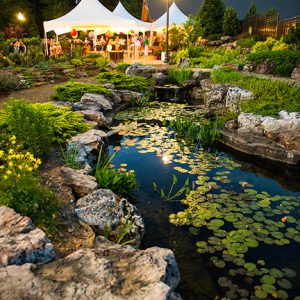calsfoundation@cals.org
Botanical Garden of the Ozarks
The Botanical Garden of the Ozarks (BGO) in Fayetteville (Washington County) opened in 2007 on acreage leased from the City of Fayetteville. The nonprofit organization is the result of a grassroots effort to establish a botanical garden with a mission of offering education, entertainment, and recreation to adults and children through a variety of events, programs, classes, and community connections. The Botanical Garden of the Ozarks is a member of the American Horticulture Society—which allows BGO members reciprocal admission to gardens and arboretums across the country—and the American Public Gardens Association, which encourages involvement in gardening for all ages.
The Botanical Garden Society of the Ozarks was incorporated in January 1994. The founder and first director was Donna Porter, who served on a volunteer basis until 1997, when a grant from the Smith Horticultural Trust of England supported the part-time position. The Fayetteville Parks and Recreation Advisory Board approved the concept of the garden and the lease of eighty-six acres east of Lake Fayetteville. Carl Totemeier, vice president emeritus of the New York Botanical Garden, served as the volunteer director from 2002 until his death in 2004. During this period, the Fayetteville City Council approved the BGO’s master plan and a revised lease. Construction of a timber-framed horticulture center began in 2003 with a timber framing workshop funded by the Fayetteville Advertising and Promotions Commission, and the city approved funds in 2004 to complete the building and the garden’s infrastructure.
In 2004, Ed Clement contributed funds to pay the salary of a director of garden operations. Scott Starr held that position from 2005 to 2009. Paige Mulhollan served as volunteer executive director from 2007 until 2009, followed by Dr. Gerald Klingaman. In 2010, Ron Cox was named executive director by the BGO Board. Klingaman continued to work for the garden in the position of operations director.
With grants and assistance from local, regional, and state donors, the Carl A. Totemeier Horticulture Center and the Backyard Gardens were dedicated in October 2006 with retired U.S. senator Dale Bumpers providing the keynote address. The grand opening was held from September 29 through October 4, 2007, with an official ribbon-cutting ceremony on September 30. Since that time, memberships in the garden have grown to around 1,200 and annual visitors number close to 100,000. The garden has a strong volunteer program and is a sanctioned project of the Washington County Master Gardeners. Maintenance and operations of the garden are wholly supported by admissions, sponsorships, memberships, and donations.
BGO consists of twelve demonstration gardens showing the woody, herbaceous, and exotic plant species that can be successfully grown in local gardens. David McKee, a local architect, designed a native butterfly house that opened in 2011. Education focuses on annual programs for children and classes for adults. BGO provides entertainment through a concert series, a family festival, and outdoor social events; it is also a venue for weddings, receptions, and corporate events.
Master Plan 2028 is a fifteen-year project to construct gardens and buildings south of the existing gardens around the Klingaman Arboretum. Phases 1–3 include the Visitor Center/Conservatory/Education Center and the Field to Fork Garden, a three-acre space dedicated to vegetables, fruits, and edible plants as a year-round teaching garden for area youth. Additional buildings and gardens will contribute to the garden’s mission of providing education, entertainment, and recreation for the growing northwestern Arkansas region, as well as for visitors from across the United States and the world.
For additional information:
Botanical Garden of the Ozarks. http://bgozarks.org/ (accessed September 14, 2021).
Tracy, Dustin. “Ribbon-Cutting Marks Long-Awaited Milestone for Botanical Garden Leaders.” Northwest Arkansas Times, October 1, 2007, pp. 1A, 5A.
Ward, Kate. “Garden Efforts Bear Fruit.” Northwest Arkansas Times, September 30, 2007, pp. 1A, 6A.
Judy Smith
Botanical Garden of the Ozarks
 Divergent Prosperity and the Arc of Reform, 1968–2022
Divergent Prosperity and the Arc of Reform, 1968–2022 Science and Technology
Science and Technology Botanical Garden of the Ozarks
Botanical Garden of the Ozarks  View of Four Seasons Garden Sculpture
View of Four Seasons Garden Sculpture 




Comments
No comments on this entry yet.